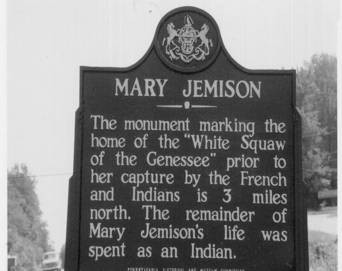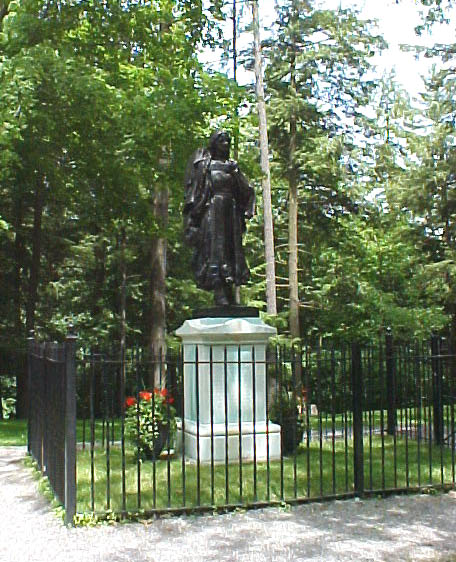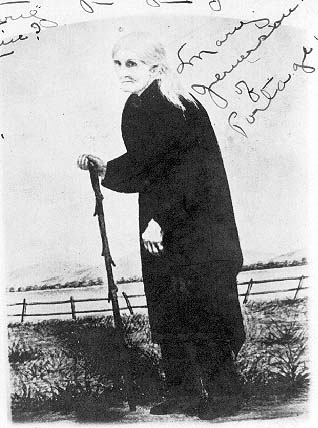|
|
Online Texts for Craig White's Literature Courses
|
|
|
selections from NARRATIVE OF THE LIFE OF MRS. MARY JEMISON
Introduction & Index |
|
Instructor's note: Mary Jemison (1743-1833) was born to Scotch-Irish parents aboard a ship crossing the Atlantic Ocean from Ireland. The family squatted in Iroquois territory (now central Pennsylvania). In 1755, during the French and Indian War, a raiding party of Shawnee Indians and Frenchmen killed and scalped her parents and older siblings, and took Mary and captured Mary and her younger siblings into captivity. Traded to Seneca Indians of the Iroquois Confederacy, Mary was renamed Deh-he-wä-mis ("a pretty girl . . . or a pleasant, good thing." After marrying a Delaware Indian, she named their son Thomas after her father. The family moved to the Genesee River area of modern New York State, her husband dying on the way. She remarried to a Seneca named Hiakatoo, with whom she had six more children. During the American Revolutionary War, the Seneca allied with the British. She helped negotiations for land sales to white settlers and told her life story to Reverend James E. Seaver, who published Narrative of the Life of Mrs. Mary Jemison in 1824.
The text is now recognized as a captivity narrative. In contrast to older captives like Mary Rowlandson who want only to return to their familiar lifestyles, younger captives like Mary Jemison could adapt to Indian ways and lose their inclination to return to white settlements.
Before her captivity Jemison had learned to read somewhat but became illiterate amid the oral-spoken Seneca culture. In 1823, ten years before her death, she was interviewed by Seaver, who by his text appears to be a workmanlike writer interested in an accurate record. The pattern of an autobiographical narrative told to a scribe or amenuensis is fairly common to early American Indian autobiography; other examples include
The excerpts linked below focus on passages relating to the captivity narrative genre or providing interesting anthropological information, though some later passages involve family quarrels with literary potential.
Elisions from the text are indicated by ellipses ( . . . ) indicating cuts of . . .
-
repetitious passages;
-
passages sounding more like Seaver's additions than Jemison's authentic voice;
-
passages of personal drama, however pathetic, such as the death of her son Jesse.
Arrangements of text below:
Chapter headings indicating contents are retained so casual readers can scan events covered. For further reading, go to complete text of Narrative of Mary Jemison (not edited).
![]()
Preface (by James E. Seaver)
Introduction (by James E. Seaver): for Jemison's appearance and speech, see paragraphs 14 & 15; her clothing, para. 18
from
CHAPTER
I.
from
CHAPTER II.
Her Education.—Captivity.—Journey to Fort Pitt. —Mother's Farewell Address.—Murder of her
Family.—Preparation of the Scalps.—Indian Precautions.—Arrival at Fort
Pitt
from
CHAPTER III.
She is given to two Squaws.—Her Journey down the Ohio.—Passes a Shawanee town
where white men had just been burnt.—Arrives at the Seneca town.—Her
Reception.—She is adopted.—Ceremony of Adoption.—Indian Custom.—Address.—She
receives a new name.—Her Employment.—Retains her own and learns the Seneca
Language.—Situation of the Town, &c.—Indians go on a Hunting Tour to Sciota and
take her with them.—Returns.—She is taken to Fort Pitt, and then hurried back by
her Indian Sisters.—Her hopes of Liberty destroyed.—Second Tour to
Sciota.—Return to Wiishto, &c.—Arrival of Prisoners.—Priscilla Ramsay.—Her
Chain.—Mary marries a Delaware.—Her Affection for him.—Birth and Death of her
first Child.—Her Sickness and Recovery.—Birth of Thomas Jemison.
from
CHAPTER IV.
from CHAPTER V.
Indians march to Niagara to fight the British.—Return with two Prisoners,
&c.—Sacrifice them at Fall-Brook.—Her Indian Mother's Address to her
Daughter.—Death of her Husband.—Bounty offered for the Prisoners taken in the
last war.—John Van Sice attempts to take her to procure her Ransom.—Her
Escape.—Edict of the Chiefs.—Old King of the tribe determines to have her given
up.—Her brother threatens her Life.—Her narrow Escape.—The old King goes
off.—Her brother is informed of the place of her concealment, and conducts her
home.—Marriage to her second Husband.—Names of her Children.
from CHAPTER VI. Peace amongst the
Indians.—Celebrations.—Worship. Exercises.—Business of the Tribes.—Former
Happiness of the Indians in time of peace extolled.—Their Morals; Fidelity;
Honesty; Chastity; Temperance. Indians called to German Flats.—Treaty with
Americans.—They are sent for by the British Commissioners, and go to
Oswego.—Promises made by those Commissioners.—Greatness of the King of England.
Reward that was paid them for joining the British. They make a Treaty.—Bounty
offered for Scalps. Return richly dressed and equipped.—In 1776 they kill a man
at Cautega to provoke the Americans. Prisoners taken at Cherry Valley, brought
to Beard's Town; redeemed, &c.—Battle at Fort Stanwix.—Indians suffer a great
loss.—Mourning at Beard's Town.—Mrs. Jemison's care of and services rendered to
Butler and Brandt.
from
CHAPTER VII.
no selections from CHAPTER VIII. Life of Ebenezer Allen, a Tory.—He comes to Gardow.—His intimacy with a Nanticoke Squaw.—She gives him a Cap.—Her Husband's jealousy.—Cruelty to his Wife.—Hiokatoo's Mandate.—Allen supports her.—Her Husband is received into favor.—Allen labors.—Purchases Goods.—Stops the Indian War.—His troubles with the Indians.—Marries a Squaw.—Is taken and carried to Quebec.—Acquitted.—Goes to Philadelphia.—Returns to Genesee with a Store of Goods, &c.—Goes to Farming.—Moves to Allen's Creek.—Builds Mills at Rochester.—Drowns a Dutchman.—Marries a white Wife.—Kills an old Man.—Gets a Concubine.—Moves to Mt. Morris.— Marries a third Wife and gets another Concubine.—Receives a tract of Land.—Sends his Children to other States, &c.—Disposes of his Land.—Moves to Grand River, where he dies.—His Cruelties. (complete text)
from CHAPTER IX.
from CHAPTER XI.
no selections from CHAPTER XII. Her Troubles Renewed.—John's Jealousy towards his brother Jesse.—Circumstances attending the Murder of Jesse Jemison.—Her Grief.—His Funeral—Age—Filial Kindness, &c. (complete text)
no selections from CHAPTER XIII. Mrs. Jemison is informed that she has a Cousin in the Neighborhood, by the name of George Jemison.—His Poverty.—Her Kindness.—His Ingratitude.—Her Trouble from Land Speculation.—Her Cousin moves off. (complete text)
from CHAPTER XIV.
Another Family Affliction.—Her son John's Occupation.—He goes to
Buffalo—Returns.—Great Slide by him considered Ominous—Trouble, &c.—He goes to
Squawky Hill—Quarrels—Is murdered by two Indians.—His Funeral—Mourners, &c.—His
Disposition.—Ominous Dream.—Black Chief's Advice, &c.—His Widows and Family.—His
Age.—His Murderers flee.—Her Advice to them.—They set out to leave their
Country.—Their Uncle's Speech to them on parting.—They return.—Jack proposes to
Doctor to kill each other.—Doctor's Speech in Reply.—Jack's Suicide.—Doctor's
Death.
no selections from
CHAPTER XV.
Micah Brooks, Esq. volunteers to get the Title to her Land confirmed to
herself.—She is Naturalized.—Great Council of Chiefs, &c. in Sept. 1823.—She
Disposes of her Reservation.—Reserves a Tract 2 miles long, and 1 mile wide,
&c.—The Consideration how Paid, &c.
from CHAPTER XVI.
|
|
|




